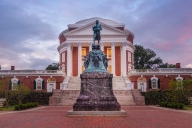You have /5 articles left.
Sign up for a free account or log in.
Students at Clemson University ended a nine-day sit-in last week outside Sikes Hall with chants, fists raised, speeches and a standing ovation from a crowd of supporters. Theirs lasted longer than others, shorter than some, and it featured one of the harsher responses from a university -- the arrest of five students attempting to occupy the Sikes building itself after it closed. The university didn't attempt to block the protest once it stayed outside.
A decision to end the sit-in, out of frustration with administrative inaction, was made by the students hours before learning the president, Jim Clements, planned to send an email promising progress on many of the protesters’ demands.
In it, he assigned timelines and “ownership” of eight initiatives to various officials. The commitments include:
- Finding an improved short- and long-term space for the campus’s Gantt Multicultural Center.
- Doubling the number of underrepresented minority faculty members by 2025.
- Progress on “telling the complete story of our historical buildings,” like that of Tillman Hall, whose segregationist namesake students have been trying to remove from the building’s name for years. The president’s email stopped short of promising actual name changes, which may be banned by South Carolina law.
- Having all employees undergo diversity training.
- Consider adding the phrase “diversity and inclusive excellence” to the university’s core values and restructuring the required orientation class for new students “to improve students’ understanding of their responsibility as members of a diverse community.”
- Committing to an as-yet-undetermined increase in the population of underrepresented students on campus.
Those hew pretty closely to student demands, though they are more restrained and with some notable exceptions. For example, students wanted the construction of a new building to provide a “safe space for students from underrepresented groups,” and they demanded the names of Tillman Hall and Calhoun Honors College be changed. Many campuses are debating whether or not to change names that honor more sinister aspects of their past, but Clemson's is a particularly stark case. Benjamin Tillman, South Carolina governor and longtime U.S. senator, participated in lynchings and boasted about it, and U.S. Senator John C. Calhoun was a leading and forceful advocate for slavery.
"The responses that came yesterday were something we’ve been asking for at least two years,” said student activist and organizer A. D. Carson. “There’s satisfaction, I suppose, but it’s bittersweet because it took so much in order to get so little.”
“I think the reason they responded this time is because it was an ongoing PR debacle from their side,” he said. “I don’t think it was for a genuine concern for the student body. If it was, then nobody would have had to sleep outside for nine days.”
Though the protests at Clemson resulted in arrests -- of both protesters (including Carson) and a student for threatening the protesters on the anonymous social media app Yik Yak -- activism on other campuses (like Duke University) seems to have garnered more national attention.
“Maybe people’s expectations about South Carolina and the dark history of South Carolina creates an expectation that this isn’t quote-unquote news,” Carson suggested. “It’s hard to garner attention when there’s a history of racial inequity and injustice on a campus where our most recognizable building is named for a violent racist and white supremacist.”
Like protesters on many other campuses, Clemson students received nods of solidarity from activists elsewhere. Duke University students, for example, posted a "love letter" that read, in part, “A sit-in is only one tactic of resistance. As you begin to move your movement forward away from Sikes Hall, we wish to say, Clemson, we love you. We see you. We're with you.”
“What [the sit-in] has done, I think,” said Max Allen, the university’s chief of staff, “is caused Clemson to take a solid look at itself, not only for the students involved in that protest but some faculty, staff and I’d add administrators who really had their eyes opened to what can we do as a community to make Clemson better for everyone.”
He noted, though, that some initiatives, such as the push to embrace and publicize even the darker parts of Clemson’s past, were already underway but hadn’t been communicated effectively to students. Allen said the university’s hands were tied as far as building names are concerned, however -- South Carolina’s Heritage Act prevents government agencies from altering the names of buildings.
Still, “it may have taken that protest to spark action in a way of urgency,” he said. “I think it’s a good thing that’s come out of this that’s going to make Clemson better for years to come … It’s going to take some time for these students to trust that we’re going to do what we say we’re going to do, but I can commit to you … that come not even a year from now they will see significant changes taking places at Clemson University in a positive way for everyone.”




